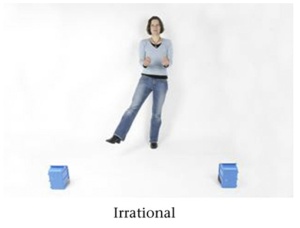Do dogs distinguish rational from irrational acts?
Animal Behaviour (2011) 81, 195-203
Juliane Kaminski, Marie Nitzschner, Victoria Wobber, Claudio Tennie, Juliane Bräuer, Josep Call, Michael Tomasello
Study Objectives: This study contributed to the body of work investigating whether dogs can distinguish rational from irrational acts. The main factor that distinguishes a rational from an irrational behavior is the efficiency of the action, given the constraints of a particular situation.
For example, in an experiment examining if children distinguish rational from irrational acts, an adult turns on a lamp with his forehead twice — on one occasion, a blanket covers his shoulders so as to appear that his hands are unavailable (making the choice to use his forehead rational); on another occasion, his hands are free yet he still uses his forehead to turn on the lamp (making his behavior irrational).
When asked to turn on the lamp themselves, children who saw the adult with his hands covered still used their hands, suggesting that they understood that the adult acted rationally and so they should as well. Yet when the children saw the adult use his forehead when his hands were clearly free, children weren’t sure of the rationality of his act and relied on imitation.
Experimental Design: The present study used two experiments to examine how dogs behave when exposed to rational and irrational acts. In the first experiment, a trained demonstrator dog showed observer dogs how to operate a food-dispensing apparatus. The apparatus could be operated with either the mouth or the paw, and using the mouth was found to be dogs’ preferred method (as that’s what dogs used when witnessing no demonstration).
In the experiment, the demonstrator dog used its paw to operate the apparatus (1) while it had a ball in its mouth (a rational act), (2) while it did not have a ball in its mouth (an irrational act) and (3) while the ball was present (hanging from the apparatus) but not in the dog’s mouth. The ‘ball present but not in mouth’ condition assessed whether the mere presence of a ball would affect the observer’s behavior (i.e. simply seeing the ball would suggest to the observer dog to use the mouth).
Experimenters wanted to see what observer dogs did when exposed to these different demonstrations. Would observer dogs attend to the rationality of the demonstrator dog’s actions?
In the second experiment, a human used her leg to gesture to one of two boxes that might contain food. In the first condition, she used her leg to gesture while books were in her hands (making the leg gesture rational). In the second condition, she used her leg when her hands were free (making the gesture irrational, possibly interpreted by the dogs as random). The purpose of this experiment was to see if dogs discriminated between rational and irrational communication. If dogs attend to rationality in this context, they would perform better when the cue was rational because the irrational cue might represent a human’s random movement as opposed to a deliberate signal.

 Main Findings: In the first experiment, the mere presence of the ball appeared to have a strong effect on observer dog behavior. Seeing a ball led to observer dogs using their mouths more, irrespective of whether the ball was in the demonstrator’s mouth or hanging from the apparatus. The findings from the second experiment suggested that dogs used the leg gesture as a visual cue to find the hidden food regardless of whether the context was rational or irrational. Both experiments in this study provided no conclusive evidence that dogs distinguish rational from irrational acts.
Main Findings: In the first experiment, the mere presence of the ball appeared to have a strong effect on observer dog behavior. Seeing a ball led to observer dogs using their mouths more, irrespective of whether the ball was in the demonstrator’s mouth or hanging from the apparatus. The findings from the second experiment suggested that dogs used the leg gesture as a visual cue to find the hidden food regardless of whether the context was rational or irrational. Both experiments in this study provided no conclusive evidence that dogs distinguish rational from irrational acts.
Study summary provided by:
Adam Chapman
Columbia University 2011
Jennifer Oh
Barnard College 2011
Ilana Yablonowich
Barnard College 2012



